The size-adjusted median dropped once again in July — at least overall.
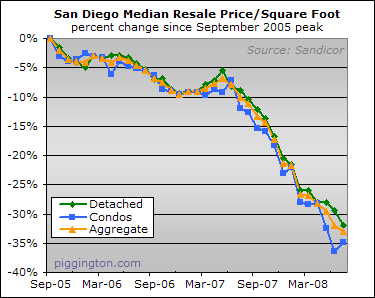
It was down a fairly painful 3.6% for single family homes, which is the worst drop since early in the year. However, it actually rose 2.4% for condos. This would be more impressive if not for the two month beatdown condos had just experienced… even after the July increase, the condo size-adjusted median was still down 9.4% from where it had been 3 months prior.
The volume-weighted aggregate of the two size-adjusted medians fell by 1.6% for the month and was down 27.3% year-over-year. Prices by this metric are now down 1/3 from the peak.
Nothing much interesting happened in the plain-vanilla median department:
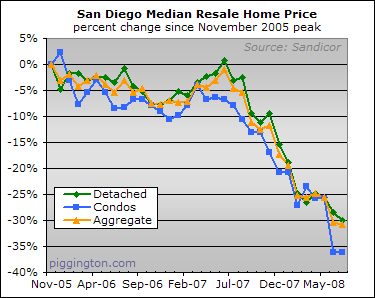
The HPI proxy based on the single-family size-adjusted median predicts a 1.9% decline for July:
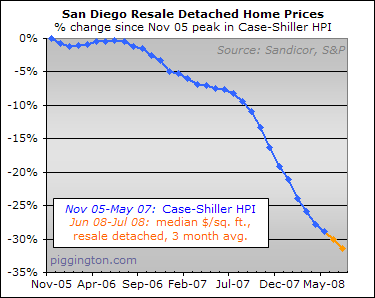
From a price standpoint, this has been just about the worst spring rally ever.
Things looked a lot brighter in terms of sales and inventory, however. Sales increased up to their 2006 levels:
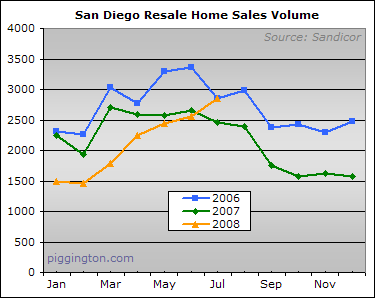
And inventory dropped below 2006 levels:
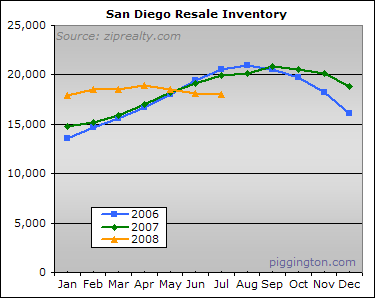
…which together led to further substantial improvement in the months-of-inventory figure.
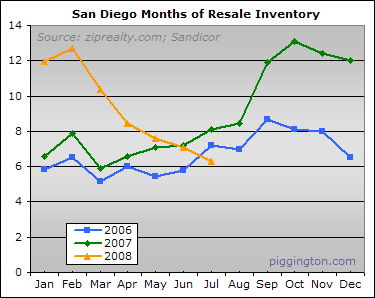
If there weren’t such a huge overhang of current and future foreclosures, the improving supply and demand balance would be a pretty compelling sign of a potential market bottom. But then there’s this chart, which shows new defaults and foreclosures piling up each month at a record-setting pace.
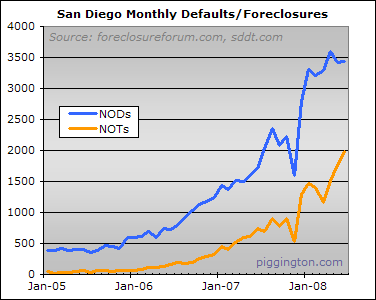
While the ratio of sales per notice of default has turned up with the recent volume surge, it remains far below the level that prevailed for the entirety of the early 1990s bear market in housing (note that neither the next graph or the prior graph denotes July’s activity):
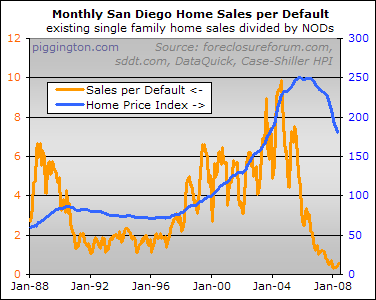
And looking forward, assorted mortgage reset charts and the local realtor’s study I recently wrote about indicate that the rate of new defaults isn’t going to decline any time soon.
So while the improving demand is a positive, it’s not enough of a positive to overwhelm the big negative that is the steady stream of new foreclosures.
One other issue to consider is the general economy. I wrote last month of the preliminary signs that San Diego employment weakness is starting to occur outside of just the housing bubble related industries. If this proves to be a trend, it would both reduce potential demand and further increase foreclosure incidence.
All in all, despite the occasional candle in the darkness, this sure doesn’t look to me like the oft-declared "housing market bottom."

Quote=Rich Toscano
If there
Quote=Rich Toscano
If there weren’t such a huge overhang of current and future foreclosures, the improving supply and demand balance would be a pretty compelling sign of a potential market bottom. But then there’s this chart, which shows new defaults and foreclosures piling up each month at a record-setting pace.
While the ratio of sales per notice of default has turned up with the recent volume surge, it remains far below the level that prevailed for the entirety of the early 1990s bear market in housing (note that neither the next graph or the prior graph denotes July’s activity)
____________________________________
Rich, from the graphs, dips in NODs and NOTs are typically suggestive of a coming upward spike.
With the heavy glut of bank problems (firing bank presidents and directors) could it be that they are reeling under the immense organizational turn over and thus don’t have the time or resources to get the soaring numbers of NOT property onto the market?
Unless this is indeed the bottom, which I think its not, I would suppose its just a temporary reprieve and that as the NOT’s are placed on the market, the months of inventory will go back up and RE prices will continue on a downward spiral.
(I like the quote feature in the last upgrade by the way….)
Mr. Mortgage reported that
Mr. Mortgage reported that the July numbers will show a record number of foreclosures up about 25% over the June numbers. About 26,500 foreclosures in CA at 12.5 billion worth of houses. I don’t see this getting better anytime soon, since those NOD’s are from about February and the NOD numbers have only gotten worse since then.
The sale numbers show that housing prices have started to come back to reality, which is a good sign. People being able to afford a house with a 30yr fixed loan, and a 10%-20% down payment is a good thing for San Diego
I agree that we are not at a
I agree that we are not at a price bottom. Maybe next year at this time.
I am watching months inventory like a hawk. It will be interesting to see how high this goes back up between now and end of the year.
Rate of foreclosures is cited as a reason to downplay the otherwise bullish numbers:
a) first year-over-year improvement in sales in a long time and
b) the return of months inventory below 2006 levels.
For historical context when did foreclosures peak during the last cycle ? Were the foreclosure numbers predictive of a turnaround ?
Don’t have that data FSD but
Don’t have that data FSD but I called my very experienced broker in regards to your question. He said foreclosures can still be high, post bottom but they are going to put a cap on things. Of course he adds the caveat that there are very many variables. Financing availability and the fact that REO’s are the making the market are still dominating variables, same as majority opinion here on the blog.
I guess that begs the question ..can REO’s not make the market, even though there are many of them? It is probably going to be a nuanced balance shift not an either or situation. Not sure what the collective dynamics will be when it happens.Probably the regular stuff of “better” economic times.
FSD: “For historical context
FSD: “For historical context when did foreclosures peak during the last cycle ? Were the foreclosure numbers predictive of a turnaround ?”
Foreclosures peaked in 1996 (July if you want a month) at 5994 for the year. Prices started increasing again at almost exactly the same time, even though foreclosure rates didn’t dip significantly until 1998.
This surprised me. I would have thought there would have been a little more of a lag between the prior foreclosure peak and price rebounding. Great question.
Looking at the data, I think one could make an argument that the rebound in prices in 1997 onward may have made the rate of foreclosures decrease (rather than the decrease in foreclosures leading to rebounding home prices). I’m not perfectly convinced of this, but the data makes the cause and effect much more murky than I had previously believed.
(based on information from Rich’s charts and http://www.foreclosureforum.com/stats.html)
Thank pencilneck for looking
Thank pencilneck for looking that up. I thought that was the case.
It may be counter-intuitive to some, but Foreclosures are a trailing indicator, not a leading indicator. Foreclosures started spiking long after other signs indicated a market downturn starting (sales, months inventory, etc).
All true, but the downturn
All true, but the downturn last time was due to an implosion of the defence industries after the cold war. CA was in a recession, and housing prices fell, and people who couldnt get another job got foreclosed on. As is usually the case, the economy wagged the housing tail.
This time, the economy was fine, it was all the funky loans that brought the whole thing down. It is a case of the tail wagging the dog, and it is hard to believe that we will see things get better when the “sickness” is still getting worse.
I know “it’s different this
I know “it’s different this time” but foreclosures are still a lagging indicator. And the reason is quite simple: Foreclosures do not subside until after prices start to recover.
SO, in 2010, 2011 or 2012 when it becomes obvious that foreclosure rates have a sustained slowdown we will already have seen evidence of a price recovery.
Does anyone have data on
Does anyone have data on inventory and sales volume for 1994,1995,1996 and 1997? This may be a better indicator of price bottoms rather than foreclosure numbers. Although it’s a little counter intuitive to have prices rise for two years before foreclosures decreased, it could be that the increase was not enough to offset the damage that lead to the property going into foreclosure? Kinda like turning an aircraft carrier 180 degrees?
If you look at the two
If you look at the two previous RE cycles in CA, the market pretty much sits on the bottom for a year or two or three before significant upward pricing begins to takes place.
july 08 foreclosures
here’s
[img_assist|nid=8573|title=july 08 foreclosures|desc=|link=node|align=left|width=432|height=552]
here’s the latest foreclosure graph including July numbers.
Even if foreclosures and
Even if foreclosures and defaults weren’t increasing and backlogged, I don’t see how anyone can talk about a bottom when unemployment is steadily rising.
Perhaps I was alittle remiss
Perhaps I was alittle remiss in explaining myself, the “sickness” isnt foreclosures, it is a worseing economy. I just dont see how we can have a housing recovery in a worsening economy. Higher unemployment, higher inflation, stagnant wages, higher interest rates, higher taxes. Housing cant improve until this is corrected, and this time around it was housing that brought us down, so I just dont see how it can recover until the economy starts to.
FSD is correct though, foreclosures are a lagging indicator. They never would have become REO if prices or poplations had kept up.
They never would have become
They never would have become REO if prices or poplations had kept up.
The prices never would have kept up, eventually they would revert to fundamentals. The loans could only have I/O, low interest and neg ams for so long but eventually the money lent had to be paid back. The foreclosures this time are not caused by a recession in San Diego, they are caused by people receiving loans that they could never hope to pay back. People are having their homes foreclosed who haven’t lost their job, gotten sick etc. the typical reasons for a foreclosure.